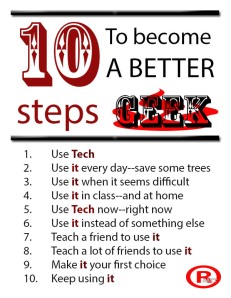May 21, 2013
5 Must-have Skills for New Tech Teachers Plus One Extra
 If you teach technology, it’s likely you were thrown into it by your Admin. You used to be a first grade teacher or the science expert or maybe even the librarian and suddenly, you walked into school one day and found out you’d become that tech person down the hall you were always in awe of, the one responsible for classroom computers, programs, curriculum, and everything in between. Now that’s you–the go-to person for tech problems, computer quirks, crashes and freezes, and tech tie-ins for classroom inquiry.
If you teach technology, it’s likely you were thrown into it by your Admin. You used to be a first grade teacher or the science expert or maybe even the librarian and suddenly, you walked into school one day and found out you’d become that tech person down the hall you were always in awe of, the one responsible for classroom computers, programs, curriculum, and everything in between. Now that’s you–the go-to person for tech problems, computer quirks, crashes and freezes, and tech tie-ins for classroom inquiry.
You have no idea where to begin.
Here’s a peek into your future: On that first propitious day, everything will change. Your colleagues will assume you received a data upload of the answers to every techie question. It doesn’t matter that yesterday, you were one of them. Now, you will be on a pedestal, colleague’s necks craned upward as they ask , How do I get the Smartscreen to work? or We need microphones for a lesson I’m starting in three minutes. Can you please-please-please fix them? You will nod your head, smile woodenly, and race to your classroom for the digital manuals (if you’re lucky) or Google for online help.
Let me start by saying: Don’t worry. Really. You’ll learn by doing, just as we teach students. Take a deep breath, engage your brain, and let your brilliance shine.
That’s the number one skill–confidence–but there are a five other practical strategies that have worked for those who came before you. Consider:
Be a communicator
Talk to grade-level teachers weekly. Scaffold your lessons with what they teach. Ask them to stay during tech class and offer on-the-spot tie-ins between what you teach and they say in class. Yes, they might want/need the time for planning or meetings, but the benefit to students of this team approach is tremendous. And it benefits the teachers, also. Many of them are not yet sold on integrating tech into their classrooms. They know they must if they’re in one of the 46 Common Core adoptive states, but they don’t like it, don’t know how to do it, and don’t see why it’s so important. When they see you do it, they will be more willing to weave it into their lessons. For example, when they hear how you reinforce good keyboarding skills, they will be more likely to insist on those traits in their classroom.
Be a risk-taker
Flaunt your cheeky geekiness. Start a Twitter feed. Use your iPhone as a timer for a speed test or the iPad to scan in art for a digital portfolio. At any opportunity, share your geek glee with students. Let them see that tech is part of life, not a subject taught in school. It’s a habit, a time-saver, a facilitator, a joy. It won’t take long to convert them. A couple of admiring glances from friends or appreciative thanks from parents and they’ll be sold.
Be an explorer
Go to the grade-level classrooms and demonstrate how technology is part of learning. This can be via iPads, the class pod of computers, the netbooks, or whatever is available. Ask students what they are doing in class and offer tech methods to make it easier. For example, are they submitting homework in a pile on the teacher’s desk? Try a drop box–or email. Could they type reports instead of handwrite them (I know–this gets philosophic, so be prepared for that discussion)? Instead of hand-drawn posters where success leans toward the artistically-talented, could they use Glogster? Encourage students to plug in during class.
Be a negotiator
You need parental buy-in on tech ed, but it is a topic typically outside their comfort zone. I often hear from 2nd grade parents that their children know more than they do (I’m talking MS Office, internet use, and online tools). Understand that this frightens them and part of your job is to mitigate their fears. Here are some ideas:
- Have your door always open. Be ready and willing to talk with them about how to complete their child’s projects–not so they can do for them, but so they feel it is within their child’s grasp. Take as long as needed and welcome them to return.
- Answer parent tech questions, even if its about a home computer problem. My experience is these are often simple, but intimidating. If you mitigate fear, you maximize support for tech ed.
- Offer a parent class that teaches the skills students are learning. Listen to your group. What makes these intelligent adults nervous about tech? Solve it for them. I often start with an agenda and end with a free-for-all, where I answer questions or help parents create fliers for soccer teams or solve home-based tech problems. It’s all good. They leave feeling I’m a partner.
This might be #6, but it may be the most important: Have a sense of humor about everything. You’re going to have computer meltdowns. It’s why robots can’t replace teachers, so embrace chaos. One of the true joys of tech is the puzzling. Why doesn’t the mouse work? Why does a website work on one computer and not another? Where’d the taskbar go? Let students see how much fun it is to engage the brain. Here are a few posters (here and here) to celebrate your status.
That’s it, just these five skills plus one. Any questions? Add a comment if you agree.
Jacqui Murray has been teaching K-8 technology for 15 years. She is the editor of a K-8 technology curriculum, K-8 keyboard curriculum, K-8 Digital Citizenship curriculum, and creator of technology training books for how to integrate technology in education. She is the author of the popular Building a Midshipman, the story of her daughter’s journey from high school to United States Naval Academy. She is webmaster for six blogs, an Amazon Vine Voice book reviewer, Editorial Review Board member for Journal for Computing Teachers, presentation reviewer for CSTA, Cisco guest blogger, a monthly contributor to TeachHUB, columnist for Examiner.com, featured blogger for Technology in Education, and IMS tech expert. Currently, she’s editing a techno-thriller that should be out to publishers next summer. Contact Jacqui at her writing office or her tech lab, Ask a Tech Teacher.







